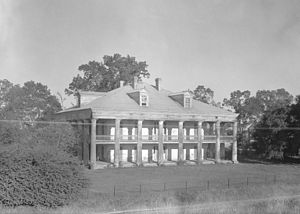
Oak Alley Plantation is a historic plantation located on the west bank of the Mississippi River, in the community of Vacherie, St. James Parish, Louisiana, U.S. Oak Alley is named for its distinguishing visual feature, an alley or canopied path, created by a double row of southern live oak trees about 800 feet long, planted in the early 18th century — long before the present house was built. The allée or tree avenue runs between the home and the River. The property was designated a National Historic Landmark for its architecture and landscaping, and for the agricultural innovation of grafting pecan trees, performed there in 1846–47 by a gardener.
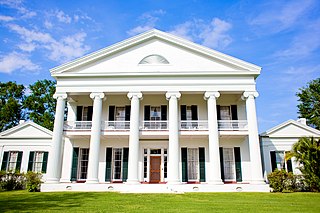
Madewood Plantation House, also known as Madewood, is a former sugarcane plantation house on Bayou Lafourche, near Napoleonville, Louisiana. It is located approximately two miles east of Napoleonville on Louisiana Highway 308. A National Historic Landmark, the 1846 house is architecturally significant as the first major work of Henry Howard, and as one of the finest Greek Revival plantation houses in the American South.
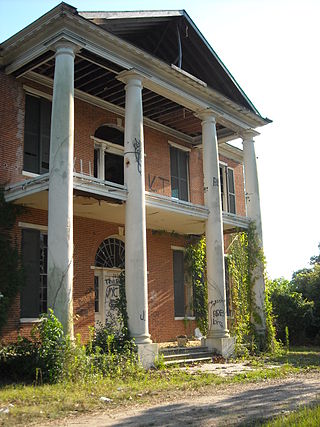
Arlington is a historic Federal style house and outbuildings in Natchez, Mississippi. The 55-acre (22 ha) property, which includes three contributing buildings, was listed on the National Register of Historic Places in 1973. It was further declared a National Historic Landmark in 1974. Following a fire that destroyed much of the main house, it was placed on Mississippi's 10 most endangered historic places for 2009 by the Mississippi Heritage Trust.

Cliveden, also known as the Chew House, is a historic site owned by the National Trust for Historic Preservation, located in the Germantown neighborhood of Northwest Philadelphia. Built as a country house for attorney Benjamin Chew, Cliveden was completed in 1767 and was home to seven generations of the Chew family. Cliveden has long been famous as the site of the American Revolutionary War's Battle of Germantown in 1777 as well as for its Georgian architecture.

Rosedown Plantation State Historic Site is an 8,000-square-foot (740 m2) historic home and former plantation located in St. Francisville, Louisiana, United States. Built in 1835 by Daniel and Martha Turnbull, it is one of the most documented and intact plantation complexes in the Southern United States. It is known for its extensive formal gardens surrounding the house.

The Conde–Charlotte House, also known as the Kirkbride House, is a historic house museum in Mobile, Alabama. The earliest section of the building, the rear kitchen wing, was built in 1822. The main section of the house was added a few decades later and is two and a half floors. The entire structure is constructed of handmade brick with a smooth stucco plaster over the exterior.

Evergreen Plantation is a plantation located on the west side of the Mississippi River in St. John the Baptist Parish, near Wallace, Louisiana, and along Louisiana Highway 18. The main house was constructed mostly in 1790, and renovated to its current Greek Revival style in 1832. The plantation's historical commodity crop was sugarcane, cultivated by enslaved African Americans until emancipation.
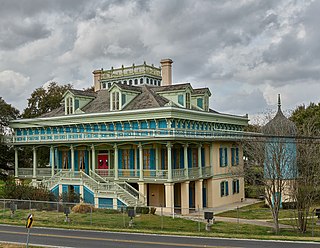
San Francisco Plantation House is a historic plantation house in Reserve, St. John the Baptist Parish, Louisiana. Built in 1853–1856, it is one of the most architecturally distinctive plantation houses in the American South. It was declared a National Historic Landmark in 1974. It is now a museum and event facility.

Ursuline Convent was a series of historic Ursuline convents in New Orleans, Louisiana. In 1727, at the request of Governor Étienne Perier, nuns from the Ursuline Convent of Rouen (Normandy) went to New Orleans to found a convent, run a hospital, and take care of educating young girls.

Nottoway Plantation, also known as Nottoway Plantation House is located near White Castle, Louisiana, United States. The plantation house is a Greek Revival- and Italianate-styled mansion built by slaves and artisans for John Hampden Randolph in 1859, and is the largest extant antebellum plantation house in the South with 53,000 square feet (4,900 m2) of floor space.
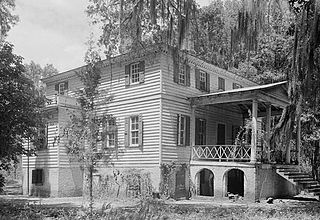
Fairfield Plantation, also known as the Lynch House is a plantation about 5 mi (8 km) east of McClellanville in Charleston County, South Carolina. It is adjacent to the Wedge Plantation and just north of Harrietta Plantation. The plantation house was built around 1730. It is located just off US Highway 17 near the Santee River. It was named to the National Register of Historic Places on September 18, 1975.
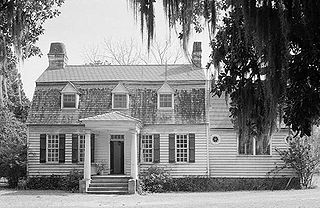
The Oakland Plantation House which is also known as Youghall or Youghal Plantation House, was built about 1750 in Charleston County, South Carolina about 7 mi (11 km) east of Mount Pleasant. It is located about 1 mile (1.6 km) south of U.S. Route 17 on Stratton Place. It was named to the National Register of Historic Places on July 13, 1977.

The Farrell Houses are a group of four houses on South Louisiana Street in Little Rock, Arkansas. All four houses are architecturally significant Bungalow/Craftsman buildings designed by the noted Arkansas architect Charles L. Thompson as rental properties for A.E. Farrell, a local businessman, and built in 1914. All were individually listed on the National Register of Historic Places for their association with Thompson. All four are also contributing properties to the Governor's Mansion Historic District, to which they were added in a 1988 enlargement of the district boundaries.

Umbria Plantation, also known as the Samuel Pickens Plantation, was a historic cotton plantation and Greek Revival-style plantation house near what is now Sawyerville, Alabama. The plantation was established by Samuel Pickens, the younger brother of Alabama's third governor, Israel Pickens. The house was an unusual example of a raised basement plantation house built on a U-shaped plan. It was recorded by the Historic American Buildings Survey during the 1930s. It was destroyed in a fire in the early 1970s.

The Houmas, also known as Burnside Plantation and currently known as Houmas House Plantation and Gardens, is a historic plantation complex and house museum in Burnside, Louisiana. The plantation was established in the late 1700s, with the current main house completed in 1840. It was named after the native Houma people, who originally occupied this area of Louisiana.
Myrtle Grove Plantation, also known as the Old Bass Place, is a plantation in Waterproof, Louisiana. It was added to the National Register of Historic Places in 1979.

The Ormond Plantation House is a French Colonial-style, Creole plantation house located in Destrehan, St. Charles Parish, Louisiana, United States.

Folly is a historic plantation house located near Staunton, Augusta County, Virginia. The house was built about 1818, and is a one-story, brick structure with a long, low service wing and deck-on-hip roof in the Jeffersonian style. It has an original rear ell fronted by a Tuscan order colonnade. The front facade features a tetrastyle pedimented portico with stuccoed Tuscan columns and a simple lunette in the pediment. A similar portico is on the north side and a third portico was replaced by a wing added in 1856. The house closely resembles Edgemont near Covesville, Virginia. Also on the property are contributing original brick serpentine walls, a spring house, smokehouse and icehouse.

Bocage Plantation is a historic plantation in Darrow, Ascension Parish, Louisiana, about 25 miles (40 km) southeast of Baton Rouge. The plantation house was constructed in 1837 in Greek Revival style with Creole influences, especially in the floorplan. Established in 1801, the plantation was added to the National Register of Historic Places on June 20, 1991.
The Malus-Beauregard House, previously known as the Rene Beauregard house, is a home built in 1832-1833 and significantly altered in 1850's to a Greek Revival style overlooking the Battle of New Orleans battlefield. Located in St. Bernard Parish about 6 miles east of the City of New Orleans and adjoining the field of Chalmette where the Battle of New Orleans was fought in 1815. The house is named after its first and last owners and served as a country residence for several wealthy families during the 19th century. Its latest use was the Visitor's Center for the Chalmette Battlefield but has been closed since Hurricane Katrina due to its poor condition. It is not considered of historical importance due to it being located on the famous battlefield but unrelated and built after the event. No restoration efforts are planned.
